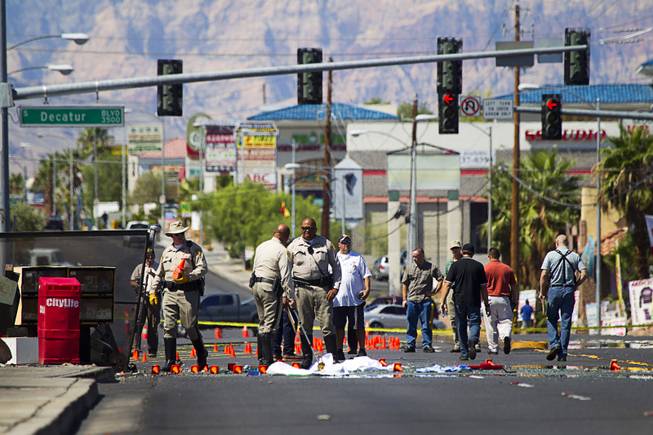
Metro Police investigate after a car crashed into a bus stop on Spring Mountain Road east of Decatur Boulevard, killing four people, on Thursday, Sept. 13, 2012.
Wednesday, May 14, 2014 | 2 a.m.
A car crash can happen in a matter of seconds, leaving a trail of wreckage in its wake.
There is often an element of chaos that makes it difficult to determine how the vehicles collided.
Last year, Metro Police’s fatal detail responded to 190 wrecks it deemed either serious or fatal. It’s their job to parse through the chaos and figure out what happened in the seconds leading up to those crashes.
Every crash leaves a trail of evidence, from the location of debris to the size of a skid mark. The answer to what happened is often at the end of a long equation, and it’s almost always because of avoidable mistakes, Metro Sgt. Richard Strader said.
Here are the steps Metro’s fatal detail takes to determine who’s at fault in a car crash:
-
Step 1
Sgt. Richard Strader’s phone rings. It can be in the middle of the night or midafternoon; it doesn’t matter the time. There have been serious to fatal injuries, and his team is needed. Three fatal detail detectives are dispatched to investigate the aftermath.
-
Step 2
The detectives often arrive to gruesome scenes of crumpled cars, shattered debris and the occasional body. The investigation starts the moment they arrive.
One detective takes lead on the case and assigns the other two to investigate witnesses and document evidence. They must move quickly to photograph and mark every loose piece of debris, body and skid mark before wind or heat alter or erase them. Debris patterns and skid marks are puzzle pieces that reveal what happened when applied to the proper formula.
In total, the initial investigation takes anywhere from an hour to up to 13 hours, as it did on Sept. 13, 2012, when a car driven by Gary Lee Hosey crashed into a bus stop on Spring Mountain Road and killed four bystanders.
-
Step 3
After documenting evidence and taking witness statements, they’ll obtain a warrant to access the vehicles’ computer that controls airbag deployment and seat belt safety. These computers often contain key information that backs up investigative findings. If a driver is suspected of drunken driving, they’ll also obtain blood samples.
-
Step 4
After documenting evidence and taking witness statements, the lead detective creates a diagram of the accident and plugs the numbers into algebraic formulas.
Detectives have equations for each type of crash, from automobile-pedestrian collisions to fixed-object crashes to automobile collisions. Detectives plug the information into the formulas and solve the equations by hand.
The results give them an educated guess to what the drivers were doing seconds before the crash. They can find out their speed within 5 mph, the entry angle of the collision and at what point the drivers reacted.
-
Step 5
Once the information is confirmed, detectives will recommend charges be filed against the at-fault driver. They usually wait 90 days to file the case depending on the injury to other parties, but the cases are solved weeks prior. Detectives often will attend trials, prepared to present their evidence. Fortunately, Metro Detective Richard Tusko said, detectives have stopped being asked to prove their equations because it’s too complicated for a jury.

Join the Discussion:
Check this out for a full explanation of our conversion to the LiveFyre commenting system and instructions on how to sign up for an account.
Full comments policy